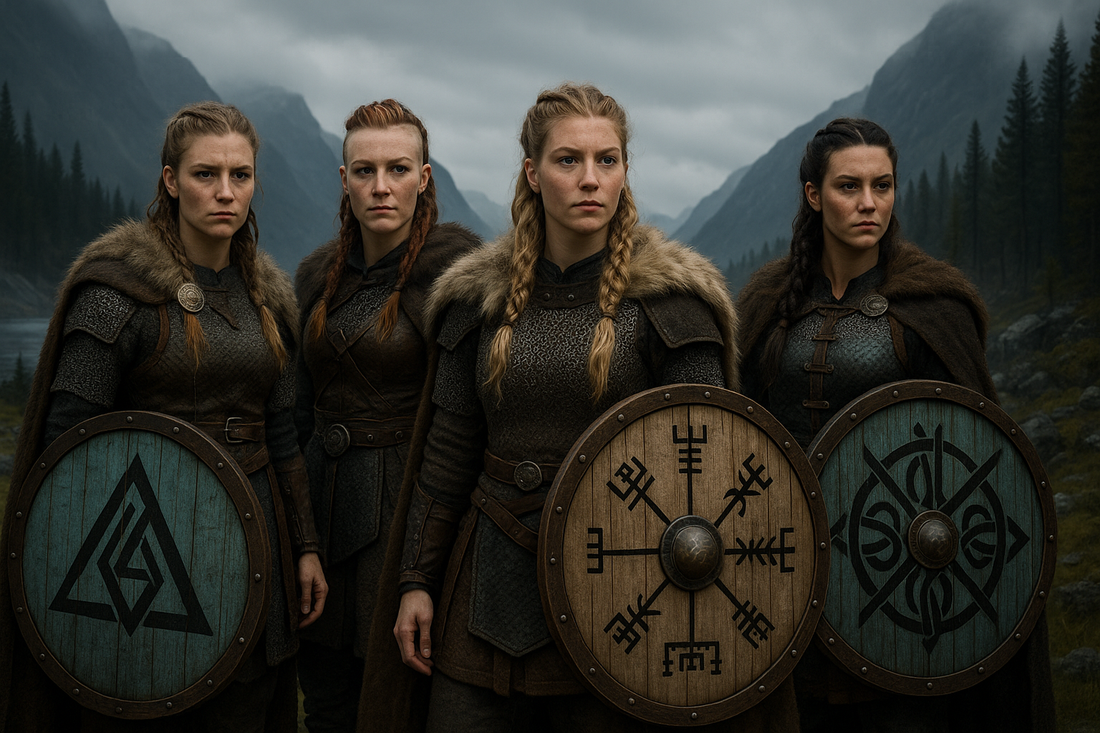
The Shield Maidens of the North: Legendary Women Warriors of Viking Age
A Note on Historical Sources: The shield maidens discussed in this article come from a mix of saga literature (written centuries after the Viking Age) and archaeological evidence. While sagas blend history with legend, recent archaeological discoveries have confirmed that some women were indeed buried with weapons in Viking society. Scholarly debate continues about the prevalence and exact roles of women warriors in Norse culture. This article presents these figures as the legends they've become while acknowledging the ongoing historical discussion.
Throughout history, the tales of fierce women warriors have captivated imaginations and challenged perceptions of gender roles in warfare. Among the most fascinating are the shield maidens of the Viking Age—women who, according to saga accounts and some archaeological evidence, took up arms alongside men, fought in battles, and earned their place in the annals of legend.
Who Were the Shield Maidens?
Shield maidens (Old Norse: skjaldmær) were women who chose the path of the warrior in Norse society. These figures appear prominently in medieval Icelandic sagas—literary works written centuries after the Viking Age that blend historical events with mythological elements and storytelling traditions.
While the historical extent of women warriors in Viking society remains a subject of scholarly debate, recent archaeological discoveries have provided intriguing evidence that at least some women were buried with weapons and military equipment, suggesting they may have held warrior or leadership roles.
Legendary Shield Maidens from the Sagas
Lagertha
Perhaps the most famous shield maiden, Lagertha appears in the Gesta Danorum by 12th-century historian Saxo Grammaticus. According to his account, she was a Norwegian warrior who fought alongside Ragnar Lothbrok. Saxo wrote that she fought with the courage of a man and was among the bravest of warriors. After proving her valor in battle, she caught Ragnar's attention and eventually became his wife.
It's important to note that Saxo was writing centuries after the events he described, and his work combines historical chronicles with legendary material.
Freydís Eiríksdóttir
Daughter of Erik the Red and sister to Leif Erikson, Freydís appears in two Icelandic sagas describing Norse voyages to Vinland (North America) around 1000 CE. The Saga of the Greenlanders tells of her defending a settlement while pregnant, picking up a sword and striking it against her chest to intimidate attackers.
The sagas portray her as both courageous and ruthless, reminding us that legendary figures were complex individuals whose stories served multiple narrative purposes.
Hervor
From the Hervarar saga ok Heiðreks, Hervor was raised as a shield maiden who dressed as a man and took the name Hjörvard. According to the saga, she became a feared Viking raider, leading her own warband across the seas. Eventually, she retrieved her father's cursed sword Tyrfing from his burial mound, claiming her inheritance and her destiny.
Hervor's tale is particularly legendary in nature, featuring magical elements alongside the warrior narrative.
Archaeological Evidence: The Ongoing Discussion
For many years, the existence of women warriors was dismissed as purely mythological. However, archaeological discoveries have complicated this picture:
- The Birka Warrior (Bj 581): A high-status Viking grave in Sweden, long assumed to contain a male warrior due to its weapons and military equipment, was proven through DNA analysis in 2017 to contain the remains of a woman. This individual was buried with a sword, axe, spear, armor-piercing arrows, and gaming pieces that some scholars interpret as suggesting tactical or strategic knowledge.
- Scholarly Debate: The interpretation of this grave remains contested. Some scholars argue the burial goods definitively indicate warrior status, while others suggest alternative explanations such as symbolic burial, inherited items, or other high-status roles. This ongoing discussion reflects the complexity of interpreting archaeological evidence.
- Other Weapon Graves: Additional graves containing women buried with weapons have been found throughout Scandinavia. However, the presence of weapons doesn't automatically confirm warrior activity—burial practices were complex and could reflect status, family lineage, or symbolic meanings.
The Shield Maiden's Legacy
Whether primarily historical figures or legendary heroes, shield maidens represent powerful themes that continue to resonate:
- Defiance of Limitations: These figures, real or legendary, represent the refusal to be confined by societal expectations.
- Complex Identity: Shield maidens navigated multiple roles—warrior, woman, leader—creating identities that transcended simple categories.
- Cultural Memory: The fact that Norse culture preserved and celebrated stories of women warriors tells us something important about their values and imagination.
- Inspiration Across Time: From medieval sagas to modern media, shield maidens continue to inspire those who refuse to accept limitations placed upon them.
The Warrior Spirit Lives On
The truth about shield maidens likely lies somewhere between pure legend and widespread historical practice. Some women in Viking society may have taken up arms, held positions of authority, or been honored with warrior burials. The sagas, while not strictly historical documents, may preserve kernels of truth about exceptional individuals who defied norms.
What remains undeniable is the power of these stories. Whether the shield maidens were common, rare, or somewhere in between, their legends remind us that the warrior spirit knows no gender. They fought not just with swords and shields, but with the courage to be themselves in a world that often demanded conformity.
Today, their legacy lives on in everyone who refuses to be limited by others' expectations, who stands up for what they believe in, and who faces life's battles with courage and determination.
The shield maidens teach us that being a warrior isn't about fitting a mold—it's about having the strength to break it.
What do you think about the historical evidence for shield maidens? Share your thoughts in the comments below!

